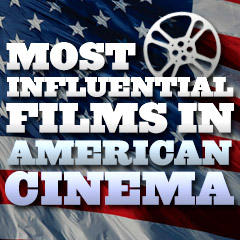Most Influential, Significant
and Important Films in American Cinema
(chronological by time period and film title)
|
|
Title Screen
|
Film Title/Year/Director/Length/Studio,
Descriptions of Influence/Significance |
Poster
|

|
The Great Train Robbery (1903)
d. Edwin S. Porter, 11 minutes (short), Edison Manufacturing Company
- American director Edwin S. Porter, chief of production
at the Edison studio, helped to shift film production toward narrative
story telling, with this quintessential western tale. It is often
credited as the first modern narrative motion picture.
- It was the most popular and commercially successful film of the
pre-nickelodeon era, and established the notion that film could be
a commercially-viable medium.
- One of the most influential westerns ever made,
and one of the first westerns (remarkably, it was filmed on the
East Coast in New Jersey - not in Hollywood).
- With innovative and modern film techniques, such
as on-location shooting, multiple camera positions (less stage-bound
camera placement), filming out of sequence and later editing the
scenes into their proper order, and parallel inter-cutting or cross-cutting
between simultaneous events (to express simultaneous action).
- In the film's fourteen scenes (or fourteen individual
shots), the narrative story with multiple plot lines was told -
with stereotypical elements that were copied repeatedly afterwards
by future westerns.
- It was also memorable for its audience-shocking,
signature final scene (placed at the beginning or end) of a cowboy
(Broncho Billy Anderson) shooting his pistol.
- The remarkable film was greeted with the same kind of fanfare that
Sam Peckinpah's violent The Wild Bunch (1969) received many years
later.
|

|

|
Gertie The Dinosaur (1914) (aka
Gertie)
d. Winsor McCay, 12 minutes (short), McCay/Vitagraph Co.
of America
- Winsor McCay's third animated film was the first "interactive" animated
cartoon, and
was the earliest example of combined 'live action' (at the beginning
and end) and animation. In the live action segment, McCay
took a ride on dinosaur Gertie's back. It would be a long time
before Who Framed Roger Rabbit (1988) duplicated
the effect.
- The title character was the first major North American
animated character - Gertie the Dinosaur.
- The animation required 10,000 drawings, all drawn
from scratch (the single-frame method). Single images projected at
a high volume of frames per second created the 'animated' effect.
- It was not, as some have claimed the first
animated cartoon. That honor belonged to Humorous Phases of Funny
Faces (1906).
|

|

|
Kid Auto Races in Venice (1914)
d. Henry Lehrman, 11 minutes (short), Keystone Film Co.
- Silent actor Charlie Chaplin was Mack Sennett's
(and Keystone Studios) most important discovery. In 1914 alone,
silent comedian Chaplin made dozens of films and became filmdom's
first great star. The mostly physical comedy and low-brow humor
in Chaplin's repertoire was marked by many pratfalls and clever
sight gags.
- Chaplin debuted his trademark small-mustached, derby-hatted,
baggy-pants, bamboo-caned 'Little Tramp' character with oversized
shoes in this short, his second picture. The
Tramp's costume was debuted in the film. It was the Tramp character's
first public appearance. The Tramp character was a popular anti-hero
figure who struggled (with ingenuity and resourcefulness) to survive
against many insurmountable forces.
- The gallant Everyman character portrayed by Chaplin
would become Keystone Studios' most popular. It also became Chaplin's
most famous, enduring and legendary character, until it was retired
at the conclusion of Chaplin's Modern Times
(1936).
- It was filmed at a home-made "pushmobiles" race
for boys in Venice, California.
|

|
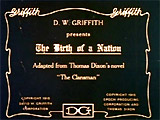
|
The Birth of a Nation (1915)
d. D.W. Griffith, 190/125/187 minutes, David W. Griffith Corp./Epoch
Producing Corporation
- A controversial, explicitly racist, but landmark
American film masterpiece - the most important picture of the silent
era.
- One of the most successful early epic films made
in the US, often cited as the greatest silent film of all time. Griffith
was keeping pace with other silent era epics from Italian filmmakers,
including The Last Days of Pompeii (1913, It.) (aka Gli
Ultimi Giorni di Pompei) and Cabiria
(1914, It.).
- At almost three hours in length
(a lengthy story narrative), it was the longest film to date. It
also had tremendous budget, at $112,000. It also featured
a full, three-hour musical score of original music, contemporary
standards such as “Dixie,” and classical
music such as Richard Wagner's Ride of the Valkyries.
- The propagandistic film was one of the biggest box-office
money-makers in the history of film, partly due to its exorbitant
charge of $2 per ticket - unheard of at the time. This 'first'
true blockbuster made $18 million by the start of the talkies.
It clearly demonstrated that film-making could be lucrative. (It
was the most profitable film for over two decades, until Disney's Snow
White and the Seven Dwarfs (1937).)
- Its release set up a major censorship battle over
its vicious, extremist depiction of African-Americans, although
Griffith naively claimed that he wasn't racist at the time. Formed
only six years earlier, the NAACP challenged the film's depiction
of the KKK, and riots broke out in a number of Northern cities,
and in other places the film was banned outright. Unbelievably,
the film is still used today as a recruitment piece for Klan membership.
Its racist overtones have engendered controversy that hasn't let
up to the present day. It proved the overriding premise that controversy
helps to fuel a film's box-office appeal.
- President Woodrow Wilson was given a private screening
of the film at the White House - a precedent - it was the first film
to be shown in the White House.
- It is the single most important and key film of
all time in American movie history - containing many new cinematic
innovations and refinements, technical effects and artistic advancements
(these many techniques are now standard features
of films, but first used in this film), including a color sequence at the
end.
- Many of the actors and others involved in the shoot,
including Lillian Gish, Mae Marsh, Donald Crisp, and Wallace Reid
went on to have long, lucrative, influential film careers. It has
been little acknowledged that many future directors appeared in
the film: John Ford (as an uncredited Klansman), Raoul Walsh (as
assassin John Wilkes Booth), and Jules White and David Butler (as
Northern/Confederate soldier extras).
- It had a formative influence on future films and
has had a recognized impact on film history and the development
of film as art. In fact, it set a negative tone for future war
films that emphasized racial hatred, conservative US isolationism,
and exclusionary nationalism up until the early 1930s.
|

|
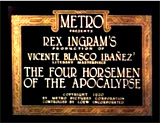
|
The Four Horsemen of the Apocalypse (1921)
d. Rex Ingram, 132 minutes, Metro Pictures Corporation
- This anti-war drama from Irish director Rex Ingram
was adapted from Vicente Blasco Ibáñez's
1916 best-selling novel about the Great War. It proved to be Metro
Pictures' most expensive big budget film, with a production budget
of almost $800,000.
- This was the first starring-lead role for Rudolph
Valentino (an Italian immigrant), who became a super-star and was
known as "The Latin Lover" (eventually overshadowed by his role
as the Sheik) as a result of the film, for his role as Argentinian
soldier Julio Desnoyers, fighting for France in WWI.
- Some have called it the first "modern" film,
for its extravagant production design, its flowing epic narrative,
and impressive special effects (and filming of battle sequences).
- Adjusted
for inflation, this war drama was the top-grossing film of its
year, and the highest-grossing silent film ever. It eventually
earned $9.2 million (domestic) - about $381.1 million in adjusted
dollars. It was one of the first films to make $1 million
at the box office. The successful production
made it financially possible for MGM Studios to be formed.
- The forbidden tango dance scene (embellished and
not in the original novel!) between Rudolph Valentino and his dance
partner (Beatrice Dominguez) in a dingy, smoke-filled Buenos Aires
Argentinian cantina (in the rough Boca district) created a tango
dance craze, and it was afterwards fashionable to wear gaucho pants.
As a footnote to the film, it inspired a young Betty Davis to try
acting.
- Screenwriter, casting director,
and film editor June Mathis became Metro Pictures' sole female
executive, and one of the first in film history, when she was selected
to produce this film. She was the one responsible for giving Valentino
his greatest film break and causing him to become a new screen
idol. As a result of The
Four Horsemen of the Apocalypse,
Mathis became one of the most powerful, well-paid and respected
women in Hollywood.
|

|

|
Nanook of the North (1922)
d. Robert Flaherty, 79/65 minutes, Les Frères Revillon/Pathé Exchange
- A forerunner of the modern documentary,
generally regarded as the first feature-length film documentary
or non-fictional narrative feature film.
- A record of life among the Inuit Eskimos in the
Arctic.
- Flaherty's film helped to usher in the documentary
film movement, although it raised some controversy because it 're-created'
or staged some of its hunting scenes, rather than being truly non-fictional.
|

|

|
The Hunchback of Notre Dame (1923)
d. Wallace Worsley, 98 minutes, Universal Pictures
- Based on Victor Hugo's 1831 novel about a deformed,
Parisian Notre Dame bell ringer named Quasimodo. The silent film
was produced by Universal Pictures studio head Carl Laemmle, at
the urging of producer Irving Thalberg, who went on to a long career
at MGM Studios.
- This was a star-making role for character actor
Lon Chaney, who soon after began his reign as the "Man
of a Thousand Faces," (probably the greatest actor
of the silent era) because
of his remarkable use of make-up (with a 20 pound hump, a wig, puffy
cheeks, false teeth, fake eye, etc.) to transform himself into the
grotesque lead character with a mis-shapen, gargoyle face and one
eye. Even so, he was able to establish a strong, emotionally-sympathetic
connection with audiences.
- There have been many versions of Hugo's novel -
this lavish period drama was the only one to rival the quintessential
1939 version with Charles Laughton. This Universal production was
reportedly the studio's biggest money maker of the silent era,
and its costliest at over $1 million. It was a remarkably massive
film production, with its 19-acre set (on the Universal City studio
backlot) including huge Gothic structures (especially the giant
cathedral), elaborate special effects, 750 crew members, and thousands
of extras.
- The fearless Chaney helped to set a high standard
for future horror films and other historical epics, as well as
illustrating how he was a master of disguise. He fully and
convincingly inhabited various roles of tortured and outcast villains
and victims in almost all of his films. One of his most impressive
and amazing silent films a few years later was Tod Browning's horror
drama The
Unknown (1927) in which Chaney (in his fourth of ten films
with Browning) masqueraded as an armless man in a gypsy circus
to evade police.
- There were no existing original 35mm prints of
the film and no camera negative, so all of the prints available
today were derived from the 16mm master version printed in 1926
- the closest to the original release known to archivists.
|

|

|
The Ten Commandments (1923)
d. Cecil B. DeMille, 136 minutes, Paramount
Pictures (as Famous Players-Lasky Corporation)
- This was director Cecil B.
DeMille's first version (silent) of the Biblical epic The Ten
Commandments, remade
in 1956 as a four-hour, entirely Biblical, VistaVision blockbuster
with Charlton Heston as the definitive Moses. Some of the biggest
successes of the 1920s were similar to the wide-screen epics of
the 50s, such as this big-budget, $1.2 million epic. It was DeMille's
first Biblical pageant and his first financially successful epic,
although his extravagant spending worried the studio at first.
It became the most popular movie attraction of 1924 and 1925.
- Unlike the 1956 film, this one was divided into
two distinct parts: the biblical Exodus (the first third), and
a present day 'modern' story (in 1923 San Francisco) that delivered
moral lessons about the consequences of breaking the commandments
for members of the McTavish Family and two females, Mary Leigh
(Leatrice Joy) and Eurasian adventuress Sally Lung (Nita Naldi).
- Always noted as a showman, Cecil B. DeMille's name
was forever associated with extravagant production values and biblical
spectacles (with rich doses of orgies and bathing scenes) that
he first filmed in the 1920s, including this film and others that
followed, such as The King of Kings (1927), The Sign of the
Cross (1932) (these two films formed a trilogy with The
Ten Commandments), Cleopatra
(1934),
The Crusades (1935), and Samson
and Delilah (1949).
- It was
the most expensive film ever made, and had
six cinematographers. The scenes of the Exodus involved at least
3,000 animals and 3,500 extras. It featured the largest set ever
constructed in movie history to that time - the 'City of the Pharoahs'
(gates 120 feet tall and 720 feet wide, and with four massive 35
foot tall Egyptian statues weighing 1,000,000 pounds). After
the big-budget film was made, the director ordered the set in San
Luis Obispo County (California) bulldozed and buried -- 60 years
later, archeologists uncovered part of the set at the location known
as the Guadalupe-Nipomo Sand Dunes.
- This early Cecil B. DeMille epic used primitive
special effects techniques (a wall of fire and other pyrotechnics),
and some segments were filmed in early two-strip Technicolor (such
as the "Exodus" segment, and the famed Red Sea sequence).
The 'parting' of the Red Sea was accomplished by filming water
as it poured down two sides of a U-shaped tank, and then running
the film backwards - to make the water appear to divide. The illusion
of keeping the walls of water separated was accomplished by slicing
a slab of jello in two and filming it in closeup - and then combining
(or double-exposing) it with live-action footage of the Israelites
walking into the distance and the Egyptian chariots in pursuit.
|

|

|
The Thief of Bagdad (1924)
d. Raoul Walsh, 155 minutes, Douglas Fairbanks Pictures
- Raoul Walsh's timeless and expensive silent costume
fantasy was a lavish and bold Arabian Nights swashbuckler-adventure
film - and a spectacular accomplishment in production design and
state-of-the-art special effects from production/art director William
Cameron Menzies. It brought film audiences to a new level of imagination
and fantasy.
- The visually-opulent film was
inspired by writer/director Fritz Lang's Der
Müde Tod (1921) (aka Destiny or The Tired Death) - the
source for the flying horse and carpet sequences, and adapted
from One Thousand and One Nights (or Arabian Nights).
- It was one of the greatest Hollywood studio silent
films ever made, and the most expensive at its time, costing over
$1 million to produce (and budgeted at about $2 million). It was
the first of four versions of the classic Arabian nights tale -
influencing the other films made in 1940, 1961 (It./Fr.), and 1978
(TV), and it also had a lasting influence on other fantasy tales.
But it was a box-office failure and underappreciated.
- It showed off revolutionary visual effects and
displayed legendary production design with its massive palace sets.
The astounding and innovative visual effects in the fairy-tale included:
a smoke-belching dragon and underwater spider, a golden
apple of the sun, an all-seeing magical crystal eye, a cloak of
invisibility, a flying horse, the famed flying carpet, and magic
armies arising from the dust.
- The storybook film featured
amazingly difficult, acrobatic stunt work performed by 40 year-old
Douglas Fairbanks (as he also did two years earlier in Robin
Hood (1922)), the first major Hollywood celebrity. He performed
with charisma and grace throughout the entire film, during a ride
high above the city on a magic carpet, a battle with a fire-breathing
dragon in caverns of flame, and a ride on the back of a flying
horse (or Pegasus). As Prince Ahmed, the titular 'Thief of Bagdad,'
he had to also battle the evil and treacherous Mongol Prince (So-Jin)
upon his return to woo back the Princess and prove his love.
|

|
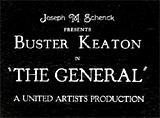
|
The General (1927)
d. Clyde Bruckman and Buster Keaton, 75/78 minutes, Buster Keaton
Productions/Joseph M. Schenck Productions (A United Artists Production)
- An imaginative, inspired masterpiece of dead-pan,
passively-unsmiling, sardonic "Great
Stone-Face" Buster
Keaton comedy. It is generally regarded as one of the greatest of
all silent comedies (and Keaton's own favorite) - and undoubtedly
the best train film ever made. The Civil War adventure-epic classic
was made toward the end of the silent era. Filmed against a backdrop
of magnificently photographed Civil War battle scenes, it also
contained one of the great chase sequences in movie history.
- Keaton's greatest picture (arguably) received both poor reviews
by critics (it was considered tedious and disappointing) and weak
box-office results (about a half million dollars domestically, and
approximately one million worldwide) when initially released in the
late 20s, and it led to Keaton's loss of independence as a film-maker
and a restrictive deal with MGM. It would take many decades for the
film to be hailed as one of the best ever made.
- Filled with hilarious sight gags and perfectly timed
stunt work, the chase comedy was written and directed by Buster
Keaton and Clyde Bruckman, and filmed with a huge budget for its
time ($750,000 supplied by Metro chief Joseph Schenck). It was
memorable for its strong story-line of a single, brave, but foolish
Southern Confederate train engineer doggedly in pursuit of his
passionately-loved locomotive ("The
General") AND the woman he loved. The two things devoted and foolish
Southern Confederate engineer Johnny Gray (Buster Keaton) loved most
in the world were his Southern belle sweetheart Annabelle Lee (Marion
Mack) and his passionately-beloved locomotive named The General.
- His stoic, unflappable reactions
to fateful calamities, his ingenious and resourceful uses of machines
and various objects (water tanks, a large piece of timber, a cowcatcher,
a rolling artillery cannon on wheels, and unattached railroad cars),
and the unpredictable forces of Nature, provided much of the plot.
- The General displayed marvelous technical and structural perfection,
playful comic inventiveness and realistic romance, and non-chalant
graceful, fluid athleticism on the part of Keaton - the Great Stone
Face. Realistic stunts (without stuntmen to double for Keaton), uncontrived,
free-flowing set-pieces, non-stop motion, and a preoccupation with
authenticity made parts of the film a visual history of the American
Civil War, with each shot looking like a Matthew Brady photograph.
- The film concluded with a climactic battle at a river gorge, with
the dramatic crash of the pursuit train into the Rock River in the
film's most spectacular scene - and the most expensive shot of the
entire silent era.
- Most comics concurrent or following Keaton were
influenced by his enduring and seminal work (deadpan comedy and
precise physical comedy), including Charlie Chaplin, the Marx Brothers,
the Three Stooges, Mel Brooks, Jackie Chan and many more.
|

|
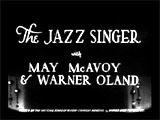
|
The Jazz Singer (1927)
d. Alan Crosland, 88 minutes, Warner Bros.
- This film remains an historic milestone
film and cinematic landmark. [Note: Most people associate this
film with the advent of sound pictures, although Don Juan (1926),
a John Barrymore silent film, had a synchronized musical score
performed by the New York Philharmonic and sound effects using Vitaphone's
system.]
- It should be made clear that this film was not the
first sound film (although that's what most people believe), nor
the first 'talkie' film or the first movie musical. It was not
actually a synchronized sound film - it was originally shot as
a silent film with the soundtrack added later.
- However, because of its timely significance, the
musical melodrama ushered in the era of the
talkies as the first film with audible dialogue. It was the first feature-length
Hollywood "talkie" film in which spoken dialogue was used
as part of the dramatic action. It was, however, only part-talkie (25%)
with sound-synchronized, vocal musical numbers and accompaniment.
There were only a few scenes, besides the musical songs, where vocal
dialogue was spoken synchronously: (1) Al Jolson's words spoken to
the camera: "Wait a minute, wait a minute. You ain't heard nothin'
yet!", and (2) Al Jolson's ad-libbed discussion with his mother while
playing the piano.
- Warner Bros.' production head Darryl F. Zanuck was
presented with a special Oscar at the very first Academy Awards
ceremony in May of 1929, "for producing The Jazz Singer,
the pioneer outstanding talking picture, which has revolutionized
the industry."
- It was a huge success, responsible for transforming
Warners into Hollywood's hottest film factory. The commercialization
of sound-on-film, and the transformation of the industry from silent
films to talkies became a reality with the success of this film.
|

|

|
Steamboat Willie (1928)
d. Ub Iwerks, 8 minutes (short), Walt Disney Productions
- Mickey Mouse's first sound cartoon was Steamboat
Willie (1928), appearing the same year as Buster Keaton's
full-length feature comedy Steamboat
Bill, Jr (1928).
- Steamboat Willie was released twice in the year
(on July 29, 1928, in limited release and then re-released on November
18, 1928 with sound and premiering at the 79th Street Colony Theatre
in New York).
- It was Disney's first cartoon
with a post-produced synchronized soundtrack (of music, dialogue,
and sound effects) and was considered Mickey Mouse's (and Minnie's)
screen debut performance and birthdate.
- It was the first sound
cartoon that was a major hit.
- Walt Disney provided the voice for
Mickey until his death.
|

|
